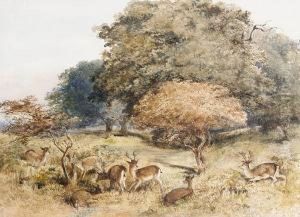Charles Henry Weigall Paintings
Charles Henry Weigall was an English artist born in 1770, whose life and career spanned across the late 18th and early 19th centuries, a period rich in artistic evolution and historical significance. Not as widely recognized today as some of his contemporaries, Weigall nonetheless contributed to the cultural and artistic landscape of his time, primarily through his work as a landscape and portrait painter. His artistic endeavors reflect the stylistic transitions of the era and offer insight into the social and cultural contexts of England during his lifetime.
Weigall’s work is characterized by its attention to detail, composition, and a keen sense of color, which he applied to both his landscapes and portraits. He was part of the broader movement in English art that saw a shift from the grandeur of history painting to the more intimate and personal genres of landscapes and portraits. This move was partly inspired by the changing tastes of art patrons and the growing middle class, who preferred art that depicted the beauty of the natural world or the likenesses of individuals. Weigall's paintings, therefore, were not just artistic expressions but also reflections of the changing societal norms and values of his time.
Throughout his career, Charles Henry Weigall managed to capture the essence of his subjects with a realism that was both flattering and detailed. While he may not have achieved the fame of some of his peers, his works were appreciated for their quality and aesthetic appeal. After his death in 1847, Weigall left behind a legacy that, though not as prominent as some, remains a valuable part of the study of the period’s art. His contributions to the art world continue to be recognized by historians and collectors who appreciate the depth and breadth of English art during the late 18th and early 19th centuries. Today, his works are held in private collections and may also be found in some museums, serving as a testament to his skill and dedication to his craft.

